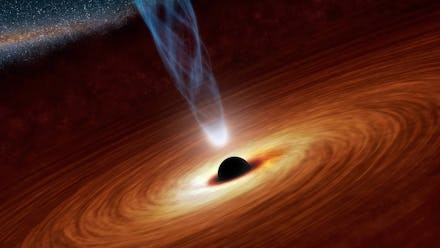A Physicist Just Created a Black Hole in a Lab — And Stephen Hawking Should Be Thrilled

A physicist has simulated a black hole in a lab, and the results of his experiment support a prediction made by Stephen Hawking in 1974. The research could help get us one step closer to solving the black hole information paradox and figuring out whether anything can survive a black hole.
Physicist Jeff Steinhauer used a cloud of super-cold atoms to create what's called an analogue black hole. It seemed to emit "Hawking radiation" in the form of quantum entangled particles called phonons, according to research published in the journal Nature Physics.
What is Hawking radiation?
Hawking realized in 1974 that black holes weren't completely bottomless pits from which nothing can escape. He proposed they actually leak a little light over time and eventually evaporate. The phenomenon is now called Hawking radiation.
The problem is it's almost impossible to observe Hawking radiation in a real black hole. This is because black holes are cooler than the cosmic microwave background radiation in the universe, according to Physics World.
That's why some physicists started working with analogue black holes. Speeding up a cloud of super-cold atoms can simulate the conditions around the event horizon of a black hole. Steinhauer did this and measured the phonons that formed. He found that atoms were sprinkled at equal distances on either side of the simulated event horizon. This suggests that pairs of phonons came from the same quantum fluctuation and were entangled with one another, which is a key component of Hawking radiation. One partner was inside the black hole and the other was emitted as Hawking radiation.
Does this experiment prove Hawking radiation?
The results are important if they can be replicated, but other physicists say we can't apply what we learn from black hole analogues to actual black holes.
"This experiment, if all statements hold, is really amazing," physicist Silke Weinfurtner told Nature. But, she said, "it doesn't prove that Hawking radiation exists around astrophysical black holes."
What's more, Steinhauer's black hole used phonons instead of photons that would be leaking from a real black hole.
Still, these analogue black holes are one of the best ways we have to study one of the most mysterious objects in the cosmos.
"Black holes are important not just for understanding black holes," Steinhauer told New Scientist. "They are important for studying new physics."